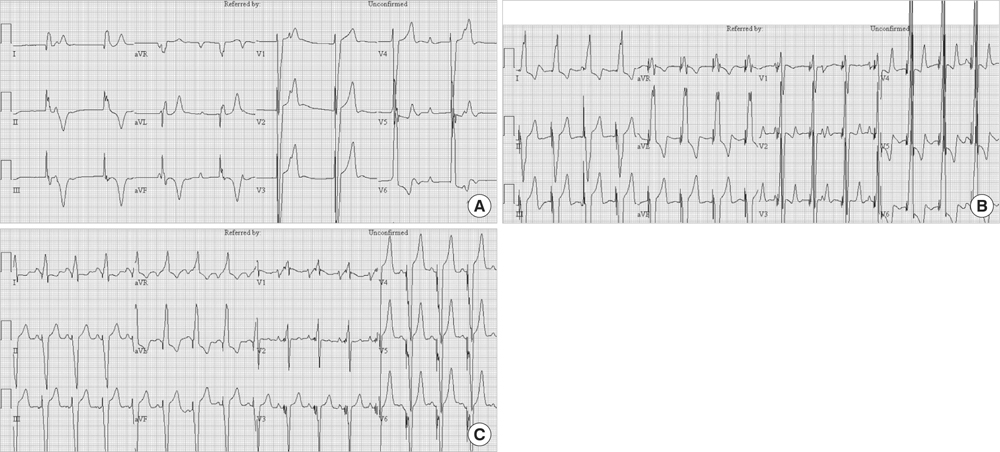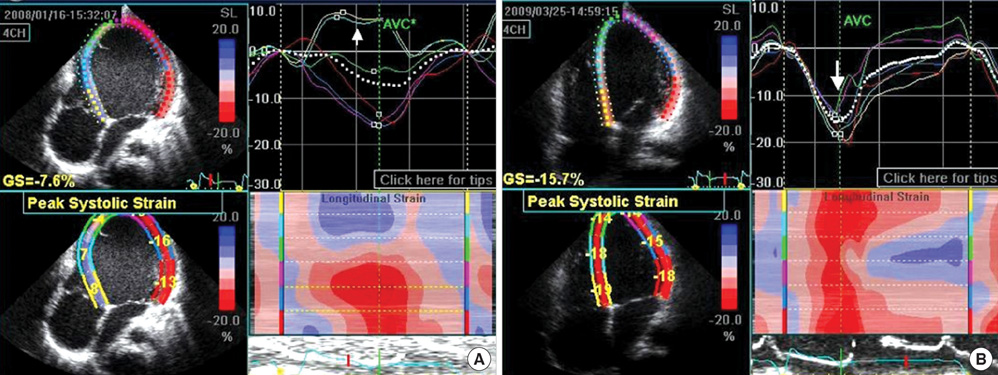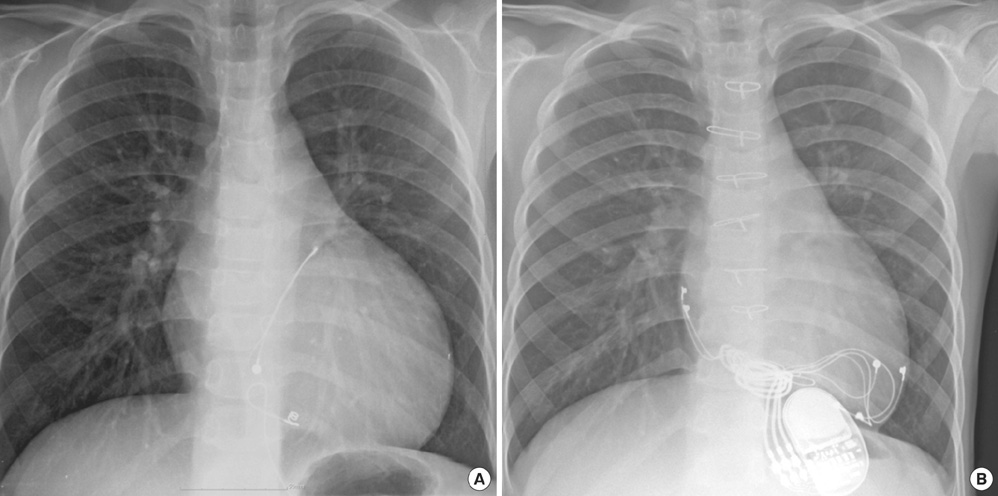J Korean Med Sci.
2010 Dec;25(12):1809-1813. 10.3346/jkms.2010.25.12.1809.
Cardiac Resynchronization Therapy for Left Ventricular Dysfunction Induced by Chronic Right Ventricular Pacing in a Child
- Affiliations
-
- 1Division of Cardiology, Department of Pediatrics, Seoul National University Children's Hospital, Seoul National University College of Medicine, Seoul, Korea. eunjbae@plaza.snu.ac.kr
- 2Department of Thoracic and Cardiovascular Surgery, Seoul National University Children's Hospital, Seoul National University College of Medicine, Seoul, Korea.
- 3Department of Pediatrics, Ewha Womans University College of Medicine, Seoul, Korea.
- KMID: 1792909
- DOI: http://doi.org/10.3346/jkms.2010.25.12.1809
Abstract
- Cardiac resynchronization therapy (CRT) has been proven its value in adult patients with congestive heart failure of low ejection fraction and wide QRS duration. Contrast to adult patients, CRT has been rarely applied for young patients. We report on a 9-yr-old boy with progressive left ventricular (LV) dilatation and dysfunction following chronic VVI pacemaker therapy for congenital complete atrioventricular block associated with maternal anti-SSA/Ro and SSB/La antibody. His LV dysfunction was improved after epicardially established CRT.
Keyword
MeSH Terms
-
Antibodies, Antinuclear/metabolism
Atrioventricular Block/congenital/therapy
Cardiac Pacing, Artificial/*adverse effects
*Cardiac Resynchronization Therapy
Child
Chronic Disease
Electrocardiography
Heart Ventricles
Humans
Male
Natriuretic Peptide, Brain/blood
Sjogren's Syndrome/immunology
Ventricular Dysfunction, Left/etiology/radiography/*therapy
Figure
Reference
-
1. Moak JP, Barron KS, Hougen TJ, Wiles HB, Balaji S, Sreeram N, Cohen MH, Nordenberg A, Van Hare GF, Friedman RA, Perez M, Cecchin F, Schneider DS, Nehgme RA, Buyon JP. Congenital heart block: development of late-onset cardiomyopathy, a previously underappreciated sequela. J Am Coll Cardiol. 2001. 37:238–242.
Article2. Thambo JB, Bordachar P, Garrigue S, Lafitte S, Sanders P, Reuter S, Girardot R, Crepin D, Reant P, Roudaut R, Jais P, Haissaguerre M, Clementy J, Jimenez M. Detrimental ventricular remodeling in patients with congenital complete heart block and chronic right ventricular apical pacing. Circulation. 2004. 110:3766–3772.
Article3. Cazeau S, Leclercq C, Lavergne T, Walker S, Varma C, Linde C, Garrigue S, Kappenberger L, Haywood GA, Santini M, Bailleul C, Daubert JC. Multisite Stimulation in Cardiomyopathies (MUSTIC) Study Investigators. Effects of multisite biventricular pacing in patients with heart failure and intraventricular conduction delay. N Engl J Med. 2001. 344:873–880.
Article4. Abraham WT, Fisher WG, Smith AL, Delurgio DB, Leon AR, Loh E, Kocovic DZ, Packer M, Clavell AL, Hayes DL, Ellestad M, Messenger J. MIRACLE Study Group. Multicenter InSync Randomized Clinical Evaluation. Cardiac resynchronization in chronic heart failure. N Engl J Med. 2002. 346:1845–1853.
Article5. Janousek J, Tomek V, Chaloupecky V, Gebauer RA. Dilated cardiomyopathy associated with dual-chamber pacing in infants: improvement through either left ventricular cardiac resynchronization or programming the pacemaker off allowing intrinsic normal conduction. J Cardiovasc Electrophysiol. 2004. 15:470–474.
Article6. Strieper M, Karpawich P, Frias P, Gooden K, Ketchum D, Fyfe D, Campbell R. Initial experience with cardiac resynchronization therapy for ventricular dysfunction in young patients with surgically operated congenital heart disease. Am J Cardiol. 2004. 94:1352–1354.
Article7. Dubin AM, Janousek J, Rhee E, Strieper M, Cecchin F, Law IH, Shannon KM, Temple J, Rosenthal E, Zimmerman FJ, Davis A, Karpawich PP, Al Ahmad A, Vetter VL, Kertesz NJ, Shah M, Snyder C, Stephenson E, Emmel M, Sanatani S, Kanter R, Batra A, Collins KK. Resynchronization therapy in pediatric and congenital heart disease patients: an international multicenter study. J Am Coll Cardiol. 2005. 46:2277–2283.8. Lee MY. Cardiac resynchronization therapy: biventricular pacing. Korean Circ J. 2006. 36:329–336.
Article9. Wilkoff BL, Cook JR, Epstein AE, Greene HL, Hallstrom AP, Hsia H, Kutalek SP, Sharma A. Dual Chamber and VVI Implantable Defibrillator Trial Investigators. Dual-chamber pacing or ventricular backup pacing in patients with an implantable defibrillator: the Dual Chamber and VVI Implantable Defibrillator (DAVID) Trial. JAMA. 2002. 288:3115–3123.10. Moak JP, Hasbani K, Ramwell C, Freedenberg V, Berger JT, Dirusso G, Callahan P. Dilated cardiomyopathy following right ventricular pacing for AV block in young patients: resolution after upgrading to biventricular pacing systems. J Cardiovasc Electrophysiol. 2006. 17:1068–1071.
Article11. Yu CM, Chan JY, Zhang Q, Omar R, Yip GW, Hussin A, Fang F, Lam KH, Chan HC, Fung JW. Biventricular pacing in patients with bradycardia and normal ejection fraction. N Engl J Med. 2009. 361:2123–2134.
Article12. Janousek J, Gebauer RA, Abdul-Khaliq H, Turner M, Kornyei L, Grollmuss O, Rosenthal E, Villain E, Früh A, Paul T, Blom NA, Happonen JM, Bauersfeld U, Jacobsen JR, van den Heuvel F, Delhaas T, Papagiannis J, Trigo C. Working Group for Cardiac Dysrhythmias and Electrophysiology of the Association for European Paediatric Cardiology. Cardiac resynchronization therapy in pediatric and congenital heart disease: differential effects in various anatomical and functional substrates. Heart. 2009. 95:1165–1171.13. Chen CA, Wang SS, Chiu SN, Wu ET, Lin MT, Wang JK, Wu MH. Left ventricular reverse remodeling after successful cardiac resynchronization therapy in a 3-year-old girl with idiopathic dilated cardiomyopathy. Int J Cardiol. 2007. 117:e7–e9.
Article14. Sinha AM, Filzmaier K, Breithardt OA, Kunz D, Graf J, Markus KU, Hanrath P, Stellbrink C. Usefulness of brain natriuretic peptide release as a surrogate marker of the efficacy of long-term cardiac resynchronization therapy in patients with heart failure. Am J Cardiol. 2003. 91:755–758.
Article15. Udink ten Cate FE, Breur JM, Cohen MI, Boramanand N, Kapusta L, Crosson JE, Brenner JI, Lubbers LJ, Friedman AH, Vetter VL, Meijboom EJ. Dilated cardiomyopathy in isolated congenital complete atrioventricular block: early and long-term risk in children. J Am Coll Cardiol. 2001. 37:1129–1134.
Article
- Full Text Links
- Actions
-
Cited
- CITED
-
- Close
- Share
- Similar articles
-
- Successful Placement of a Left Ventricular Pacing Lead Despite Coronary Sinus Dissection During Cardiac Resynchronization Therapy
- Cardiac Resynchronization Therapy Using a Dual Chamber Pacemaker in Patients with Severe Left Ventricular Dysfunction and a Left Bundle Branch Block
- Ventricular dyssynchrony in patients with permanent pacemaker
- Rapid and Potent Antiarrhythmic Effect of Cardiac Resynchronization Therapy in a Patient with Advanced Dilated Cardiomyopathy and a Large Ventricular Arrhythmia Burden
- Current Role of Conduction System Pacing in Patients Requiring Permanent Pacing





